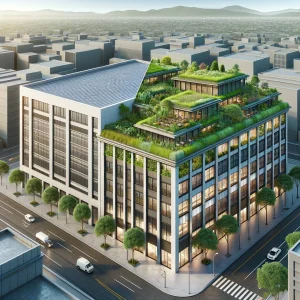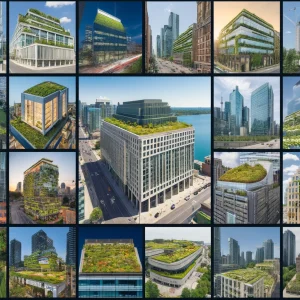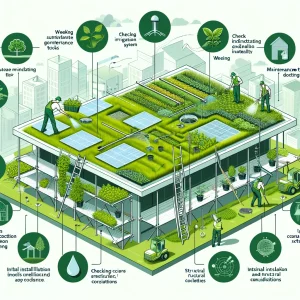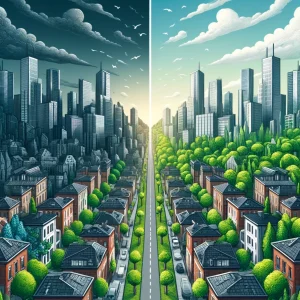Commercial buildings are increasingly adopting green roof technology in today’s urban landscape. This strategy enhances aesthetics and improves environmental footprints. Green roofs offer significant insulation benefits, saving energy and increasing building efficiency. Consequently, this blog post explores the multifaceted advantages of green roofs. It showcases exemplary commercial projects globally and addresses practical considerations for landscapers and property developers.

Benefits of Green Roofs
Green roofs are celebrated for their superior insulation. Adding a layer of vegetation atop buildings reduces heat loss during colder months and keeps buildings cooler in hot weather. This natural insulation lowers energy costs and creates a more stable indoor temperature, making the environment more comfortable for occupants.
Aesthetically, green roofs transform urban environments. They turn unused rooftops into lush, inviting spaces. These living roofs can serve as recreational areas for building occupants or as green oases in the concrete jungle. They enhance the visual appeal of buildings and contribute to the well-being of users and the surrounding community.
Environmental Impact
The environmental benefits of green roofs extend beyond energy savings. They play a crucial role in reducing the urban heat island effect, which occurs when metropolitan areas experience higher temperatures than their rural surroundings due to human activities. Green roofs absorb and retain rainwater, help manage stormwater runoff, and support biodiversity by providing habitats for wildlife.

Examples of Successful Commercial Green Roof Projects
Several commercial buildings worldwide have set benchmarks for successful green roof installations. For example, the XYZ Corporate Center in Toronto features a green roof. It covers over 50% of its available rooftop space and incorporates native plant species that require minimal irrigation. This project enhances the building’s energy performance and supports the city’s biodiversity and stormwater management goals.

Innovative Technologies and Practices
Advancements in waterproofing technology and materials have significantly improved the feasibility and durability of green roofs. Modern waterproof membranes prevent leaks effectively and withstand the root penetration of planted vegetation. Additionally, innovative irrigation systems that recycle greywater can reduce water usage.

Challenges and Maintenance
Although the benefits are substantial, green roofs come with challenges. The initial installation cost can be high, and the building’s structural integrity must be evaluated to support the extra weight of a green roof. Furthermore, regular maintenance is essential to ensure the roof’s longevity and effectiveness. Maintenance includes periodic weeding, replanting, and irrigation system checks.
Landscapers specializing in green roofs should familiarize themselves with local building codes. They might also seek partnerships with structural engineers and architects. Staying updated on the latest materials and techniques is crucial for delivering sustainable and successful projects.
Green roofs are an innovative and sustainable choice for commercial buildings. They offer benefits like enhanced insulation, aesthetic improvements, and environmental conservation. As urban areas expand, the role of green roofs in sustainable development will undoubtedly grow. For landscapers and developers, embracing this technology means contributing to a greener planet and tapping into a market that values innovation and sustainability.
